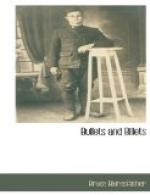On arriving up at St. Yvon for our third time round there, we—as usual now—went into our cottage again, and the regiment spread itself out around the same old trenches. There was always a lot of work for me to do at nights, as machine guns always have to be moved as occasion arises, or if one gets a better idea for their position. By this time I had one gun in the remnant of a house about fifty yards away from our cottage. This was a reserve gun, and was there carrying out an idea of mine, i.e., that it was in a central position, which would enable it to be rapidly moved to any threatened part of the line, and also it would form a bit of an asset in the event of our having to defend the village.
The section for this gun lived in the old cellar close by, and it was this cellar which gave me an idea. When I went into our cottage I searched to see if we had overlooked a cellar. No, there wasn’t one. Now, then, the idea. I thought, “Why not make a cellar, and thus have a place to dive into when the strafing begins.” After this terrific outburst of sagacity I sat down in a corner and, with a biscuitload of jam, discussed my scheme with my platoon-commander pal. We agreed it was a good idea. I was feeling energetic, and always liking a little tinkering on my own, I said I would make it myself.
So Hudson retired into the lean-to and I commenced to plot this engineering project. I scraped away as much as necessary of the accumulated filth on the floor, and my knife striking something hard I found it to be tiles. Up till then I had always imagined it to be an earth floor, but tiled it was right enough—large, square, dark red ones of a very rough kind. I called for Smith, my servant, and telling him to bring his entrenching tool, I began to prize up some of the tiles. It wasn’t very easy, fitting the blade of the entrenching tool into the crevices, but once I had got a start and had got one or two out, things were easier.
I pulled up all the tiles along one wall about eight feet long and out into the room a distance of about four feet. I now had a bare patch of hard earth eight feet by four to contend with. Luckily we had a pickaxe and a shovel lying out behind the house, so taking off my sheepskin jacket and balaclava, I started off to excavate the hole which I proposed should form a sort of cellar.
It was a big job, and my servant and I were hard at it, turn and turn about, the whole of that day. A dull, rainy day, a cold wind blowing the old sack about in the doorway, and in the semi-darkness inside yours truly handing up Belgian soil on a war-worn shovel to my servant, who held a sandbag perpetually open to receive it. A long and arduous job it was, and one in which I was precious near thinking that danger is preferable to digging. Mr. Doan, with his back-ache pills, would have done well if he had sent one of his travellers with samples round there that night. However, at the end of two days, I had got a really good hole delved out, and now I was getting near the more interesting feature, namely, putting a roof on, and finally being able to live in this under-ground dug-out.




